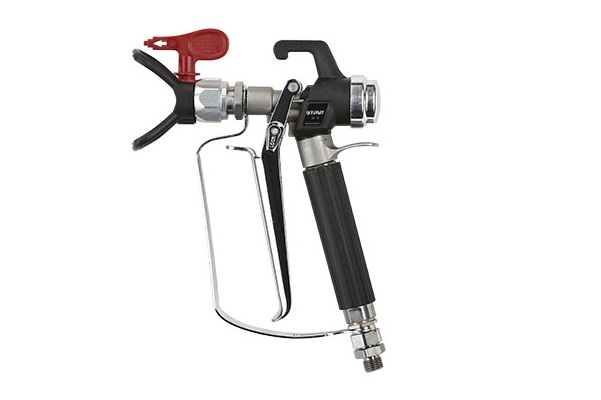How To Spray With A Spray Gun
Using a spray gun is easy. It’s more continent and it gives that ‘finishing touch’ everyone desires to see. There are several things you can use a spray gun for. Perhaps you like plants? Use a spray gun to wash the dirt off those gentle leaves. Most of the time however, Spray guns are used for painting purposes.
The painting was one of the basic reasons they created spray guns. Given its convenience and efficiency, it’s quite preferable over regular brushes. Where brushes leave marks, called brush marks, these don’t. Unless handled improperly. That’s why you’re here. This little piece of writing might give you a general idea of using a spray gun.
SAFETY COMES FIRST
Whether you’re using the spray gun for spraying pesticides, fertilizers, insecticides, paint or anything else, you need to handle the equipment with safety. Unless it’s the water you’re spraying. Which is something people rarely do? But Hey, one can never overlook diversity now can they.
Safety comes first. The spray gun throws tiny fine droplets into the air. Even if it’s not a windy day, the droplets can still travel in the air. You wouldn’t want to inhale the droplets and solvents particles. Neither would you want the droplets to land on your skin, because your skin loves to absorb things
So in that context. Here’s what you should do:
- Wear safety glasses. It will help prevent solvent, otherwise toxic, Vapor from hurting your eyes
- Wear A Filter mask. So you don’t inhale the tiny droplets of whatever your spraying.
- Get some Rubber Gloves on. Preferably long ones
- Make sure you’re wearing long sleeve shirt
- Finally, it would be nice to have some hearing protection. Headphones perhaps? If you want to preserve your hearing power afterward.
USING A SPRAY GUN
Now comes the real deal. The actual usage of the spray gun. However before you dive into handling one, turning it one and start making the world more beautiful. Some things you must know.
Basic parts you ought to know about:
One of the basic things you must know about is electric spray parts. Of the parts, two are the most important. The regulator and the compressor.
The regulator has a water trap. This is very useful specially in a humid environment. It traps the moisture in the mixture. Something that if left unchecked can destroy the quality of the mixture. If it’s paint, having water in oil-based paint would be the only thing you’d need to turn a good day into a bad one.
Normal spray guns have 2 regulators. One near the compressor and one near the gun. Both of these are equally important.
The compressor, as the name suggests, compresses. It builds up the pressure so that the substance being sprayed shoots out of the hose with max velocity. It’s the compressor that adds moisture to the air hoses. The regulator removes the water afterward.
The good thing about compressors is that you need not worry if the original compressors not working properly. You can always use the compressor of a refrigerator or an air conditioner compressor of your car. If that doesn’t work either. Get a smaller spray gun and a bigger air tank. This should work. Also, you can always wait for pressure build-up during shots.
Brushing:
This can be both power brushing or wire brushing. Normally, brushing is to remove any dust whatsoever on the substance you are going to spray on. But if it’s a pesticide you’re spraying, you don’t need brushing now do you? Skip this part if that’s the case.
Brushing ensures that the dust, or metal flakes, or wood flakes are out of the way. We need great visuality for the final product. Use wire brushes if the unwanted particles are less coherent. Use power brushing if the unwanted is more adherent. Either way, brushing is a must.
The strokes:
Not necessarily if the gun is in use for farming purposes. In which case, just add the- whatever you want to spray- in the machine with the right proportions. The proportion for making a mixture should be given on the packaging of the substance, fertiliser for instance. Get the proportions, pour it in and spray away. Use headphones too by the way. They’ll come in handy.
In case the spray gun is used for painting, it’s the usual purpose. Strokes can make a borderline difference between perfect and horrible. The spraying motion is an art. For great strokes, move the gun at constant velocity back and forth. Always push the button after the gun is up to speed. Release the button before the end of the stroke. Keep your speed constant, because if you slow down even slightest, excess paint will accumulate at that point and will scream the words of imperfection. It’s good to practice beforehand.
Remember to overlap the strokes, wet on wet. This creates an overall finer look.
If you get runs even after perfect strokes; it means one of two things. Either too much paint is present or too much solvent is present. Recreate your mixture. Finally, use lighter coats. Wait till the coat dries and put in another coat. Do this until you achieve satisfaction.
DONE
And good work we are done. Using spray guns is most technical in the case of paints. That’s why the major example of this article paints. Because once you know how to work around paints using spray guns, any other solvent is just as easy as spraying water.


